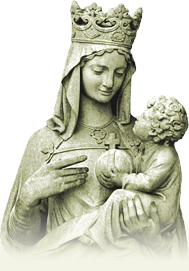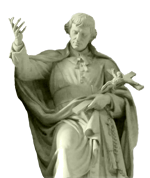PRESENTATION
Veritas Articles comprise a range of studies about Religion, History, Art, Science and Faith, Politics and Society under a Catholic approach and depth.´Little galley, with no pretensions. Not a huge transatlantic. A frail little galley in the chaotic sea of modern crisis. We are little. We are weak. We are few. But the Catholic truth is our treasure. Fight for the truth – Veritas – is our ideal. Fight for Him who said: ‘Ego sunt Veritas’, Christ, Our Lord. It is the sun of Catholic truth that gilds out frail galley. And it is golden just because it carries in its arks, in the bottom of its soul, the treasures of roman apostolic catholic creed’s truths. It is the faith spirit that pulsates on its white sail stamped with the cross of blood. It is the Cruzade’s wind that pulls it. And let us cingler to Lepanto.’
By the time we wrote this lines on the launching editorial of the pressed and extinguished Newpaper Veritas, in 1998, we were only 20 ‘remos de plata’ [silver paddles]. Now we have grown: we have many paddlers ‘ remos de oro’ [golden paddles]: electronic golden paddles.
VERITAS HIGHLIGHTS
Conspiracy in History: Examples from the Old Testament
The conspiracy in History and the doctrine behind it.
Hail to the Pope!
In times of religious and ecclesiastical crisis - specially when it reaches the highest authorities of the Church - two opposite temptations usually appear: revolt against the Pope"s authority or accept in silence all error, by respect of authority.
Gnosis: the occult religion in history
With the fall of communism, what has already manifested itself here and there, was spread throughout all our skeptical twentieth century: there was a great boom of mysticism
Defeat with honor*
The Law of the Biocrime was approved by the Brazilian Congress. Montfort Cultural Association, turn ourselves to You, oh God Almighty, claiming for justice, grace and forgiveness.
Doctrine and Art
According to the common sense art has one single end: to please. If it were said that the artistic works can be, and are, powerful means to spread ideas, they, surprised, would doubt it. And this is “the state of ideological innocence" which eases the assimilation of false religious, philosophical and ideological systems through art.
Two histories: The Spiritual Franciscans and Pope Celestine V (Saint Peter Celestine), and the Quietism and Blessed Innocent XI, Pope
The pretension that the mere approval of the Neo-Catechumenate Statutes would be a doctrinal approval lacks any juridical basis and reveals a great deal of ignorance about the doctrine of the papal infallibility and about the History of the Church.
A FEW THOUGHTS for AUGUST, 2005
Cardinal Ratzinger recently made the following admission to an Austrian bishop who is a friend of his: ‘I have two problems on my conscience: Archbishop Lefebvre and Fatima. As to the latter, my hand was forced. As to the former, I failed’.”
From Ratzinger to Benedict
Benedict XVI was present at all four sessions of the Second Vatican Council from 1962 to 1965. Whereas Karol Wojtyla took part as a bishop, the young Joseph Ratzinger did so as a theological expert. During and after the council he taught successively at the universities of Bonn (1959-1963), Münster (1963-1966), Tübingen (1966-1969), and Regensburg, until he was appointed Archbishop of Munich in 1977. In 1981 he became prefect of the Congregation for the Doctrine of the Faith, a post he held until the death of John Paul II in April 2005.
Benedict XVI censures “the mind of Second Vatican Council”
Comment on the address of the Pope Benedict XVI to the members of the Roman Curia, in the last December 22nd
´To liberate the Mass of Saint Pius V is to condemn the II Vatican Council by means of a symbol`, said Pope Paul VI
The liberation of the Everlasting Mass is, in fact, at least symbolically, a condemnation of the Second Vatican Council
Antichrist Alert! Cardinal Biffi Rouses the Church
The archbishop emeritus of Bologna delves back into the famous story by Vladimir Soloviev and applies it to the Christianity of today. A collateral target: Cardinal Martini
What now? How does ecumenism end up? How dows Second Vatican Council end up?
"With the Vatican II Council, the "seeds of the Word", expression of Saint Justin, were used as base of the ecumenical ideology. It was said, so, at the conciliar rooms, that in the pagan religions one could find "seeds of the Word"...
Dossier: The Motu proprio of Bento XVI
Vatican II operated in the context of tradition and in tradition is set the legitimacy of the Ordo of Paul VI which is not in opposition to that of his predecessor, it never has been. So, no liturgical book or part of it has been abrogated, unless it contained errors: which happened precisely for the Institutio generalis Missalis Romani in 1969 when it had just been published and which Paul VI suspended for certain doctrinal ´inaccuracies` and then had published again in May 1970 with amendments made at paragraph 7.








